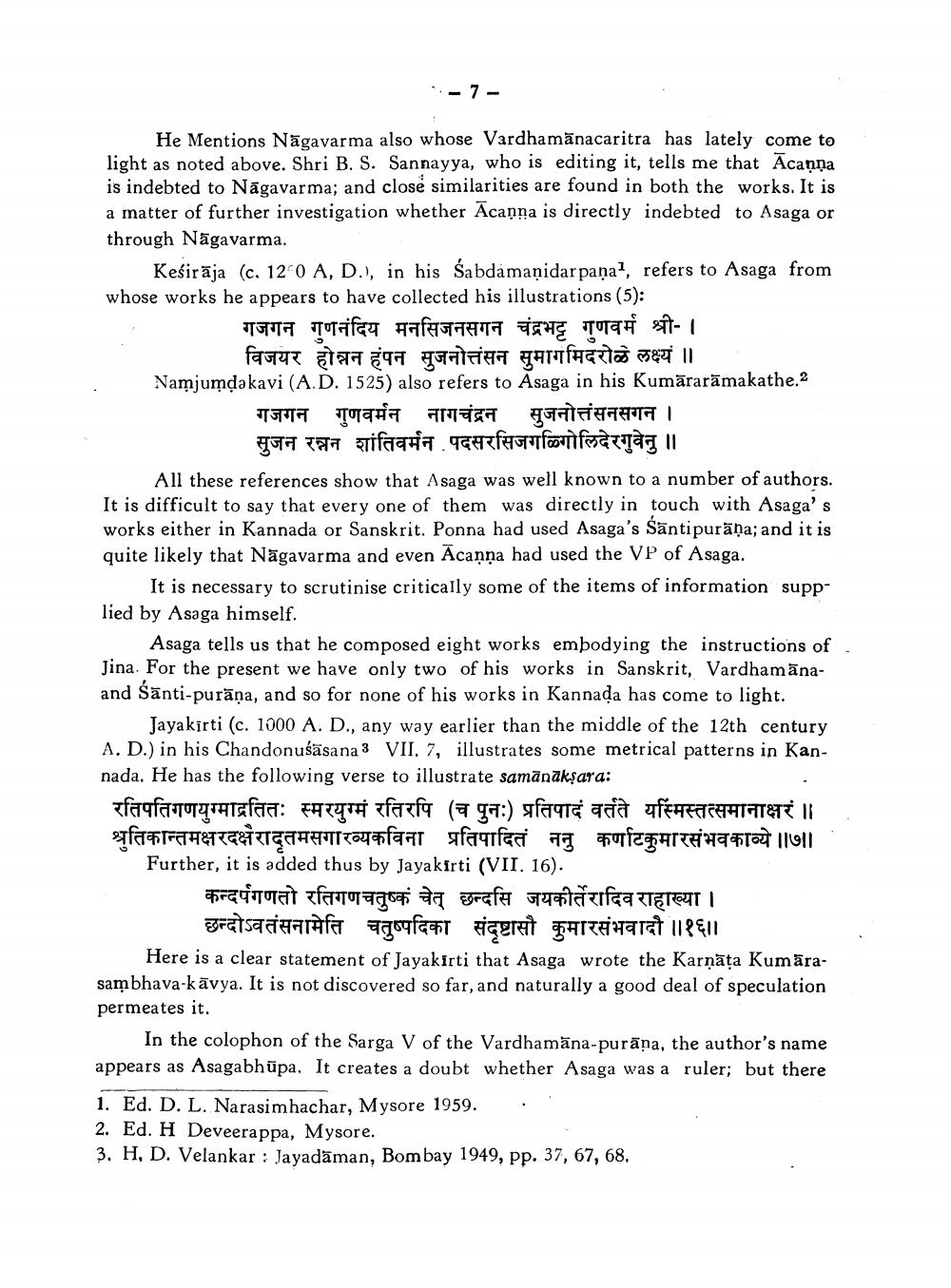________________
-7
He Mentions Nāgavarma also whose Vardhamānacaritra has lately come to light as noted above. Shri B. S. Sannayya, who is editing it, tells me that Acanna is indebted to Nāgavarma; and close similarities are found in both the works. It is a matter of further investigation whether Acaņna is directly indebted to Asaga or through Nāgavarma.
Kesiraja (c. 120 A, D.), in his Sabdamanidarpana, refers to Asaga from whose works he appears to have collected his illustrations (5):
गजगन गुणनंदिय मनसिजनसगन चंद्रभट्ट गणवर्म श्री-।
विजयर होन्नन इंपन सजनोत्तंसन समागमिदरोळे लक्ष्यं ।। Namjumdakavi (A.D. 1525) also refers to Asaga in his Kumārarāmakathe.2
गजगन गुणवर्मन नागचंद्रन सुजनोत्तंसनसगन ।
सुजन रन्नन शांतिवर्मन पदसरसिजगळिगोलिदेरगुवेनु ॥ All these references show that Asaga was well known to a number of authors. It is difficult to say that every one of them was directly in touch with Asaga's works either in Kannada or Sanskrit. Ponna had used Asaga's Sāntipurāņa; and it is quite likely that Nägavarma and even Ācaņņa had used the VP of Asaga.
It is necessary to scrutinise critically some of the items of information supplied by Asaga himself.
Asaga tells us that he composed eight works embodying the instructions of Jina. For the present we have only two of his works in Sanskrit, Vardhamānaand Šānti-purāņa, and so for none of his works in Kannada has come to light.
Jayakirti (c. 1000 A. D., any way earlier than the middle of the 12th century A. D.) in his Chandonusāsanas VII. 7, illustrates some metrical patterns in Kannada. He has the following verse to illustrate samānākşara: रतिपतिगणयुग्मादतितः स्मरयुग्मं रतिरपि (च पुनः) प्रतिपादं वर्तते यस्मिस्तत्समानाक्षरं ॥ श्रुतिकान्तमक्षरदरादृतमसगारव्यकविना प्रतिपादितं ननु कर्णाटकुमारसंभवकाव्ये ॥७॥ Further, it is added thus by Jayakirti (VII. 16).
कन्दर्पगणतो रतिगणचतुष्कं चेत् छन्दसि जयकीर्तेरादिवराहाख्या।
छन्दोऽवतंसनामेति चतुष्पदिका संदृष्टासौ कुमारसंभवादौ ।।१६।। Here is a clear statement of Jayakirti that Asaga wrote the Karnāta Kumārasambhava-kävya. It is not discovered so far, and naturally a good deal of speculation permeates it.
In the colophon of the Sarga V of the Vardhamāna-purāna, the author's name appears as Asagabhūpa. It creates a doubt whether Asaga was a ruler; but there 1. Ed. D. L. Narasimhachar, Mysore 1959. . 2. Ed. H Deveerappa, Mysore. 3. H. D. Velankar : Jayadaman, Bombay 1949, pp. 37, 67, 68.




